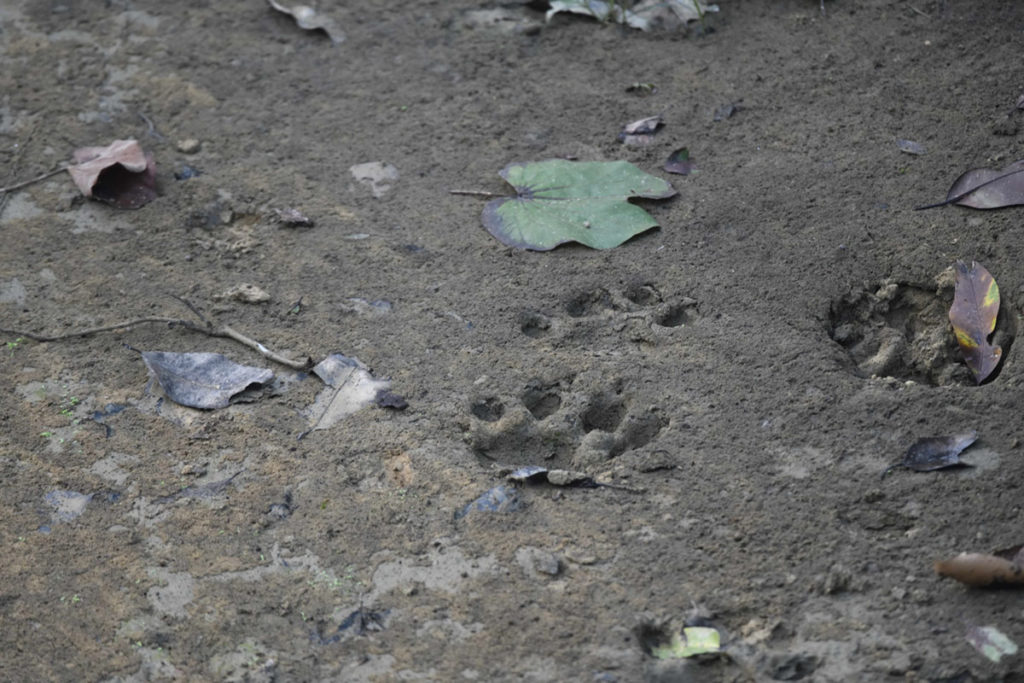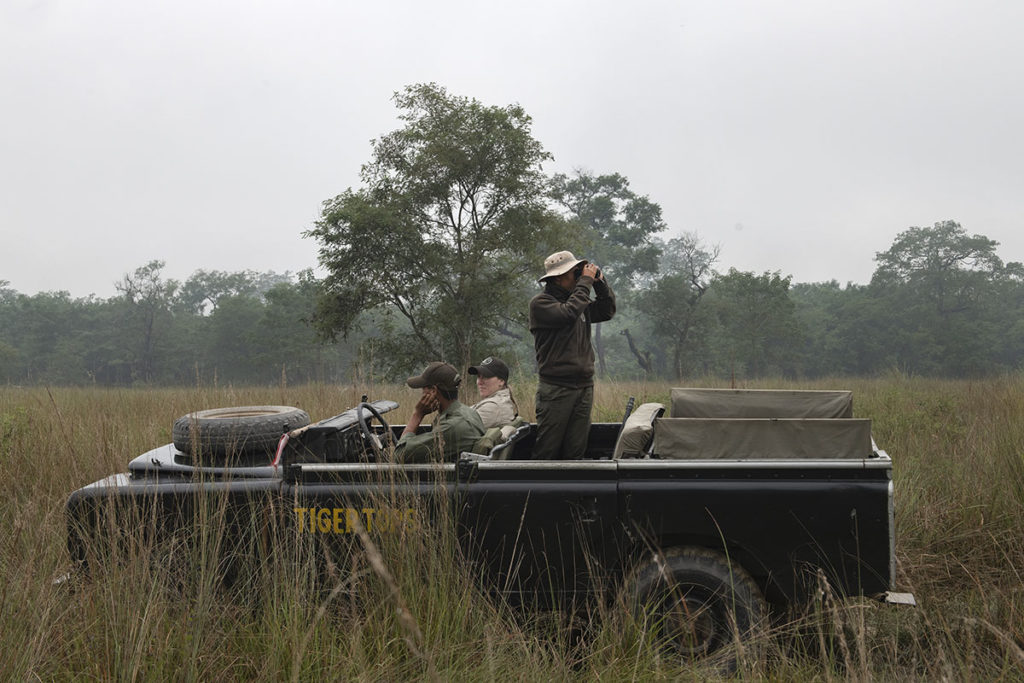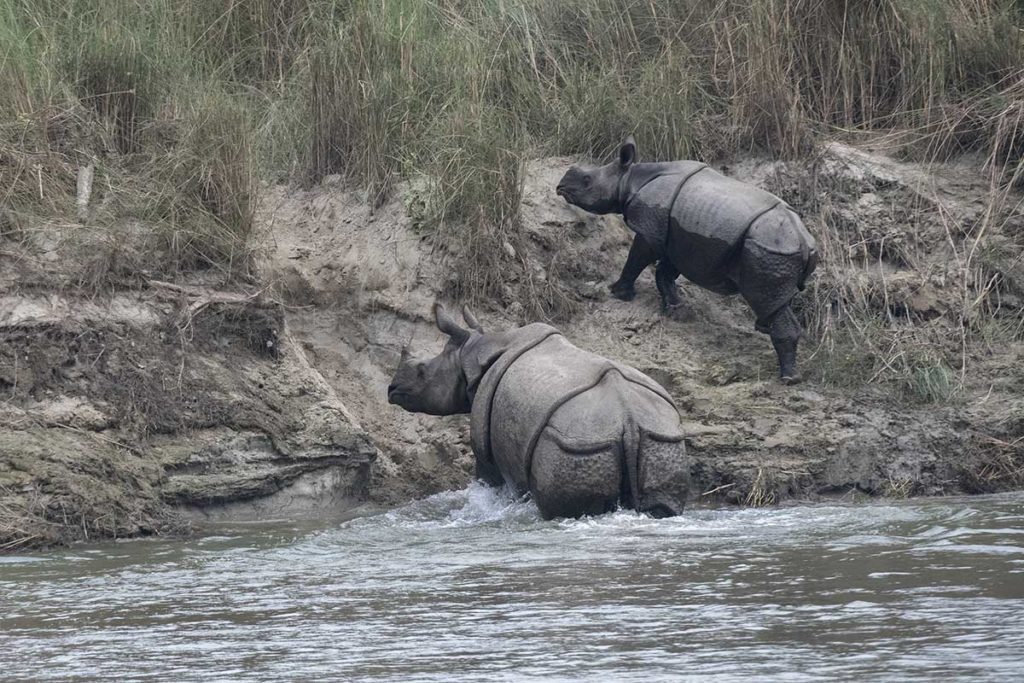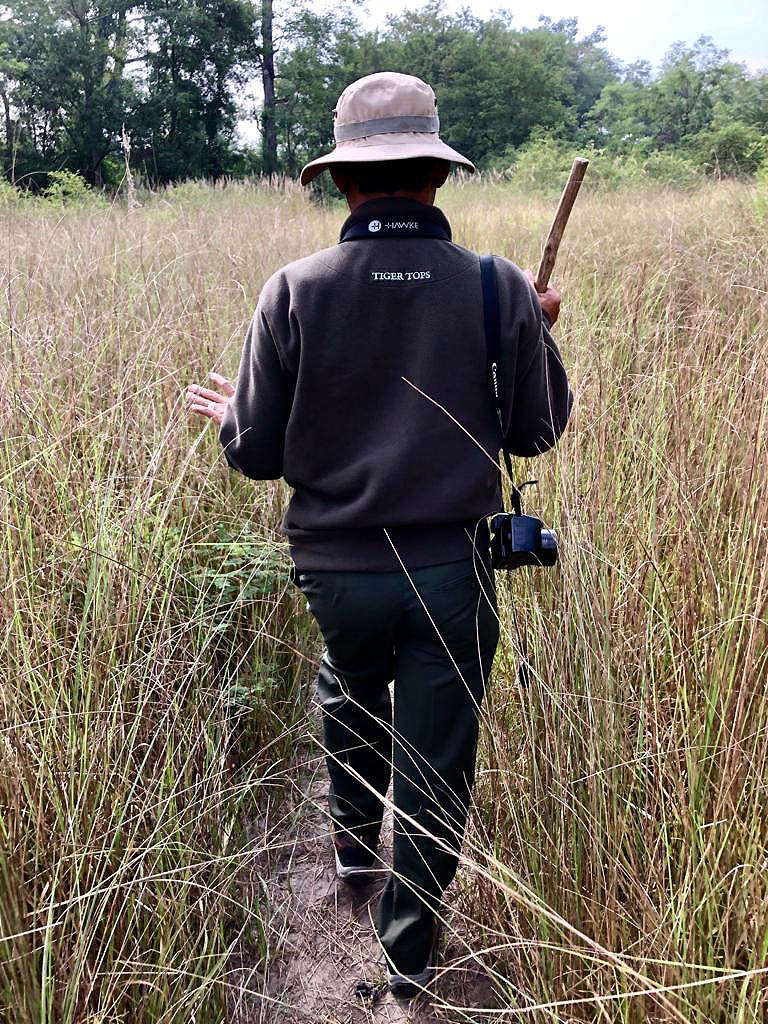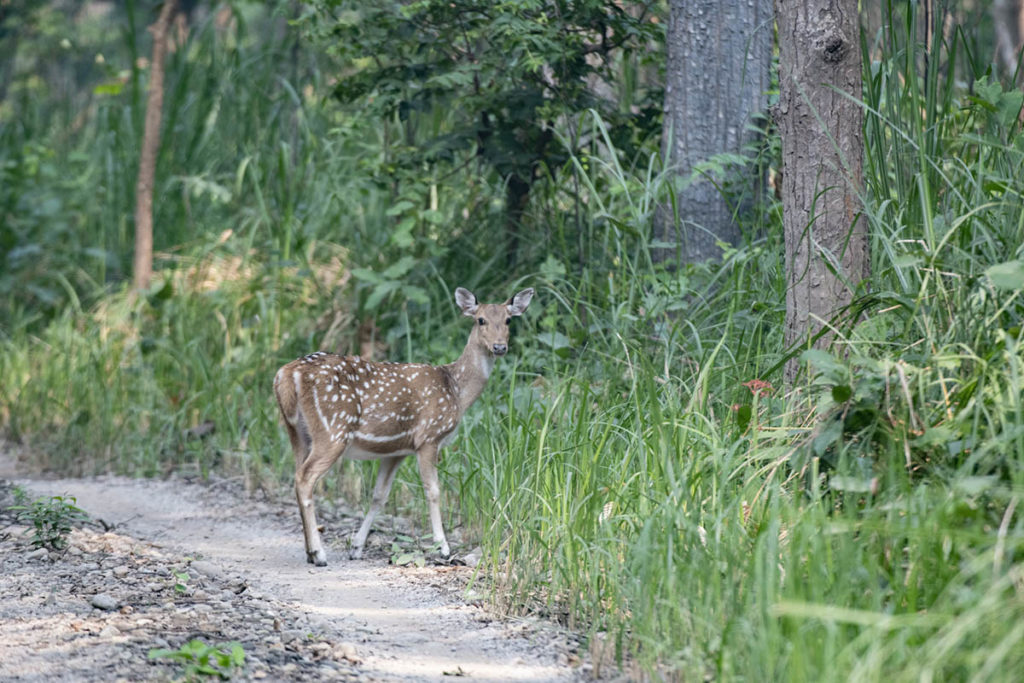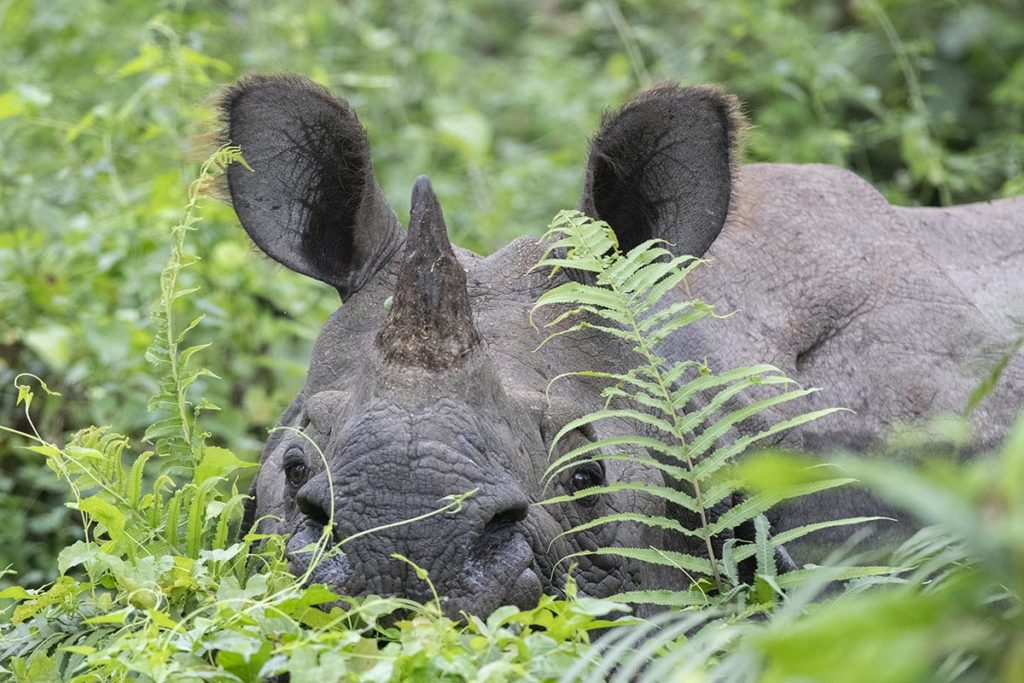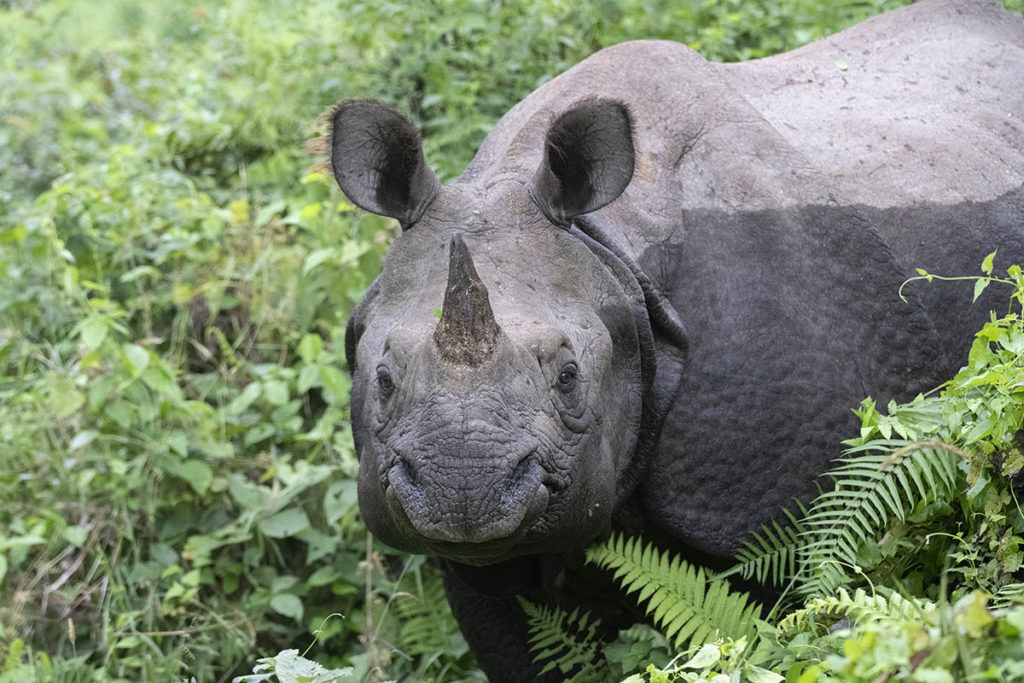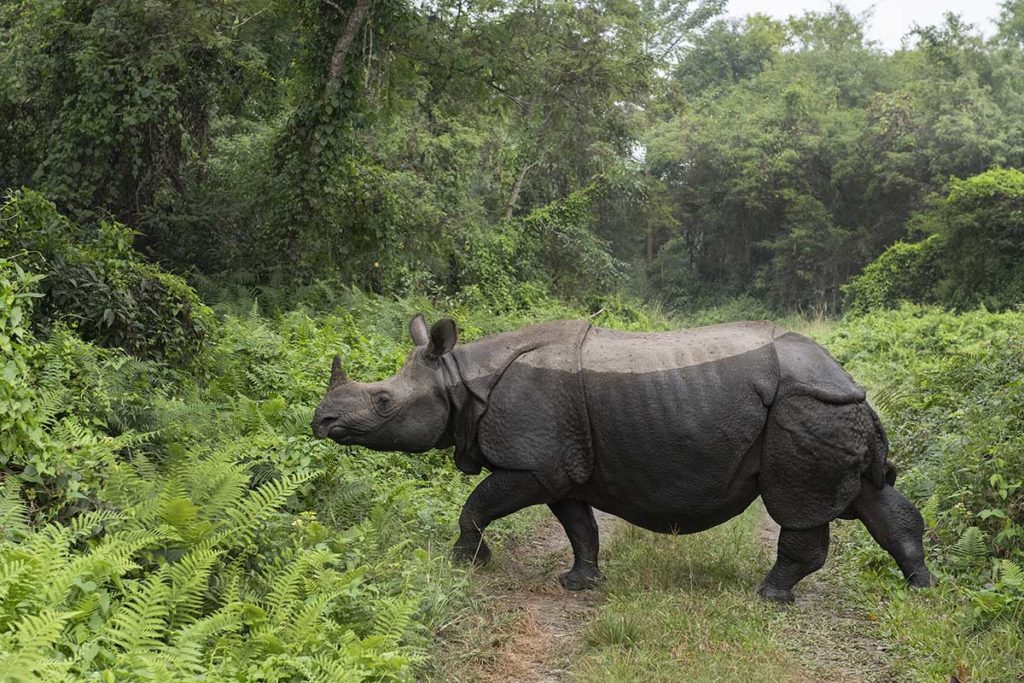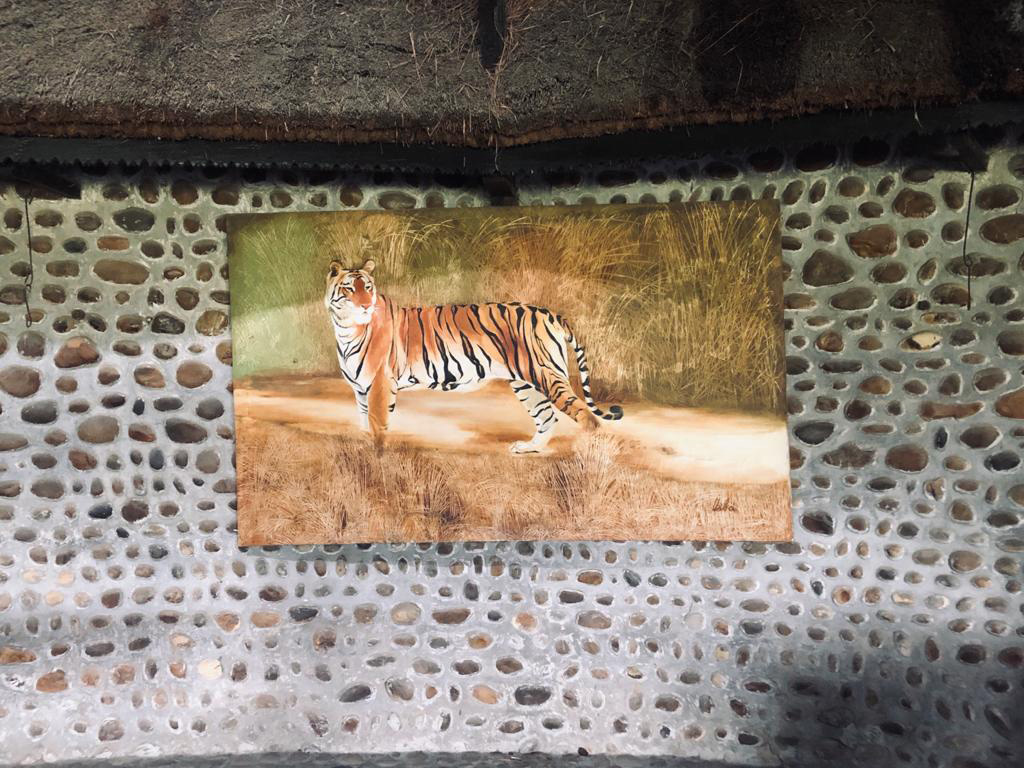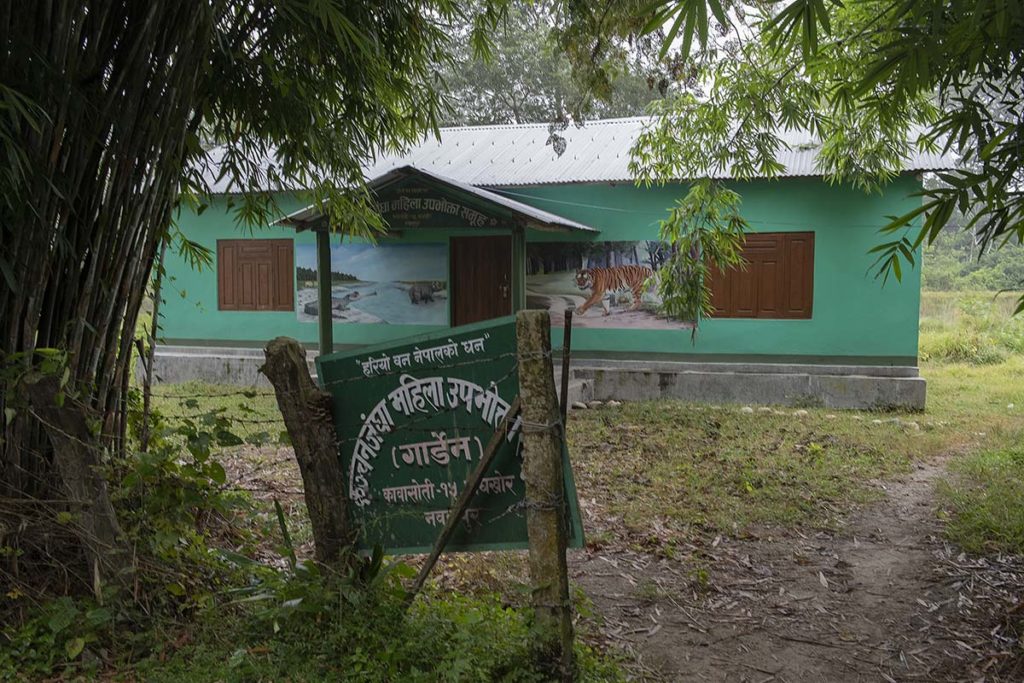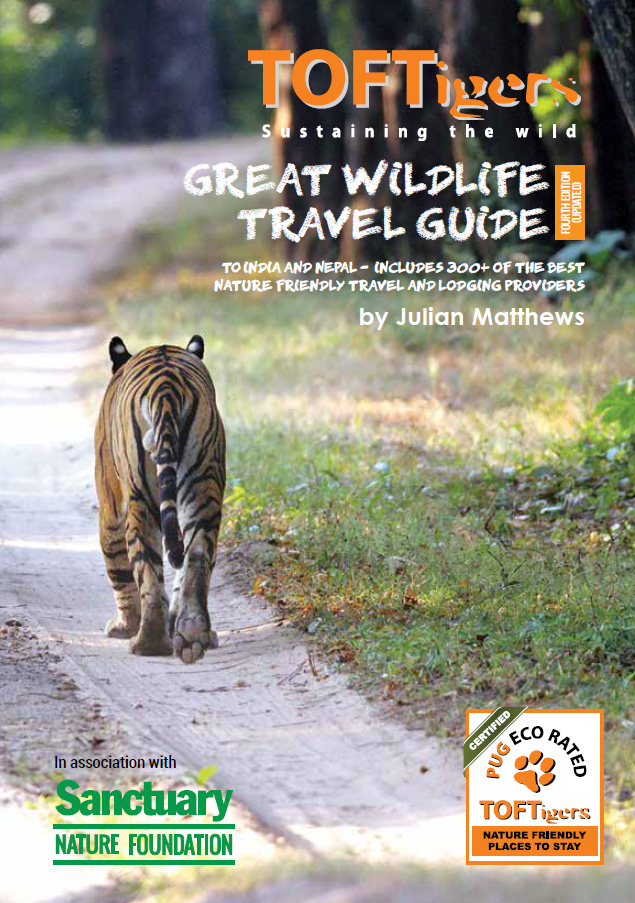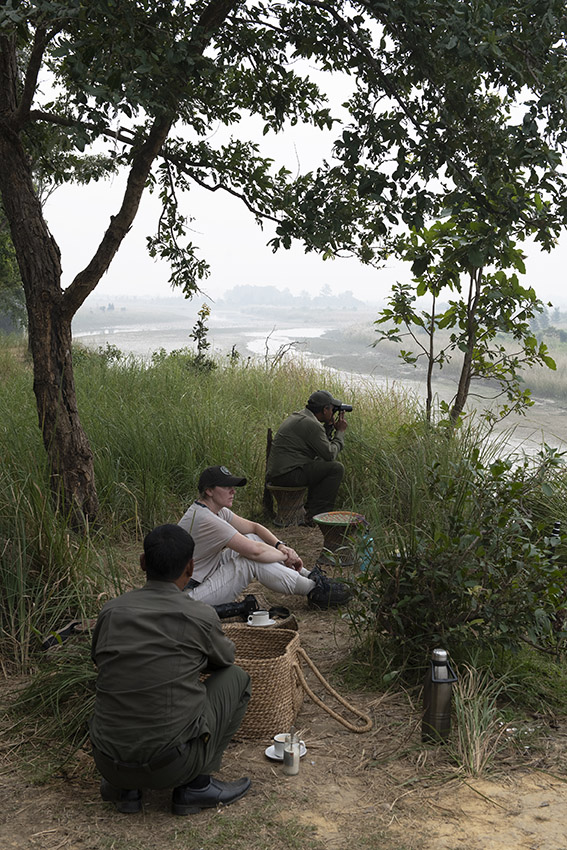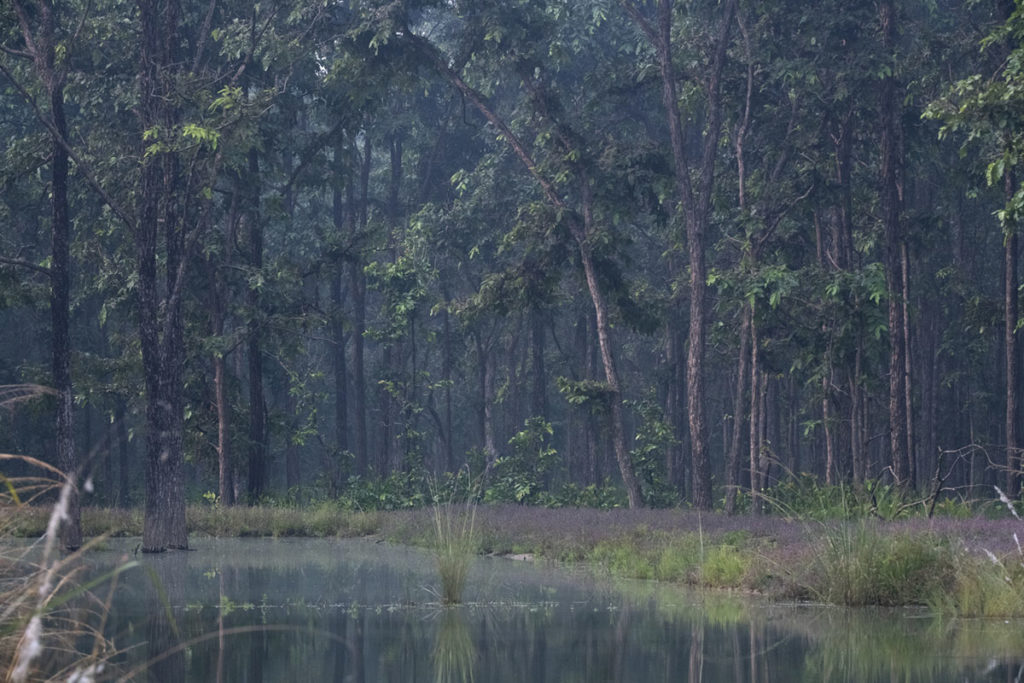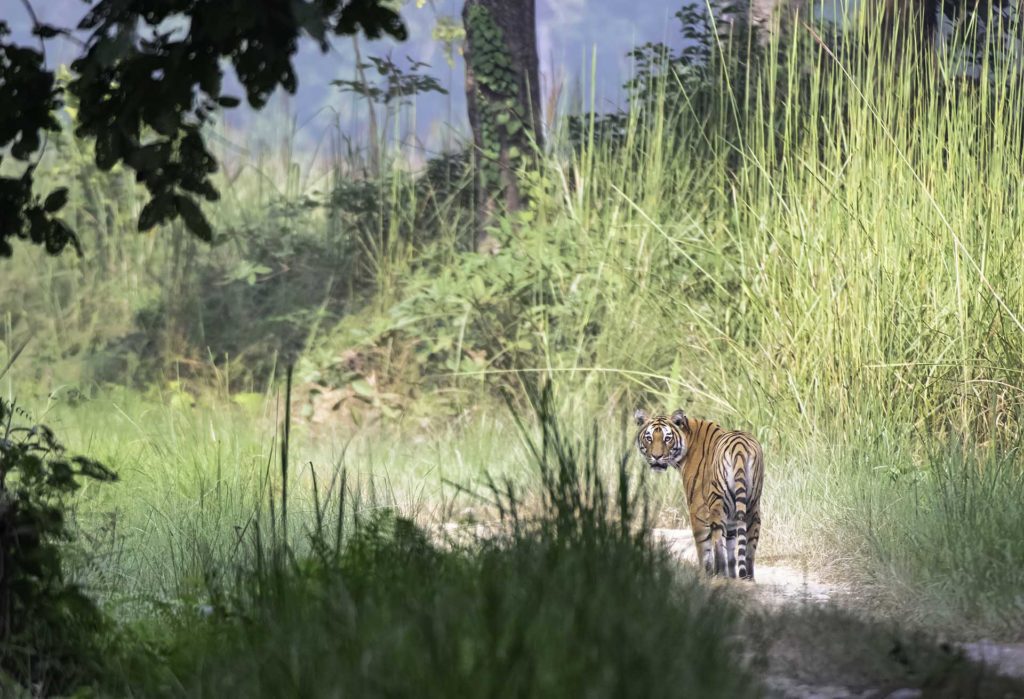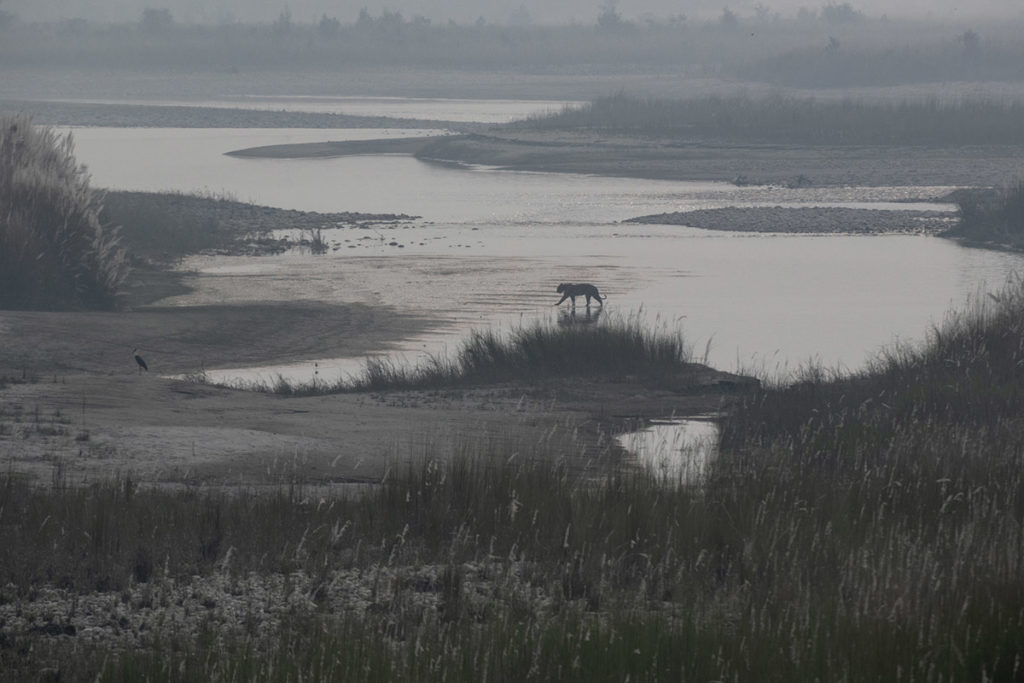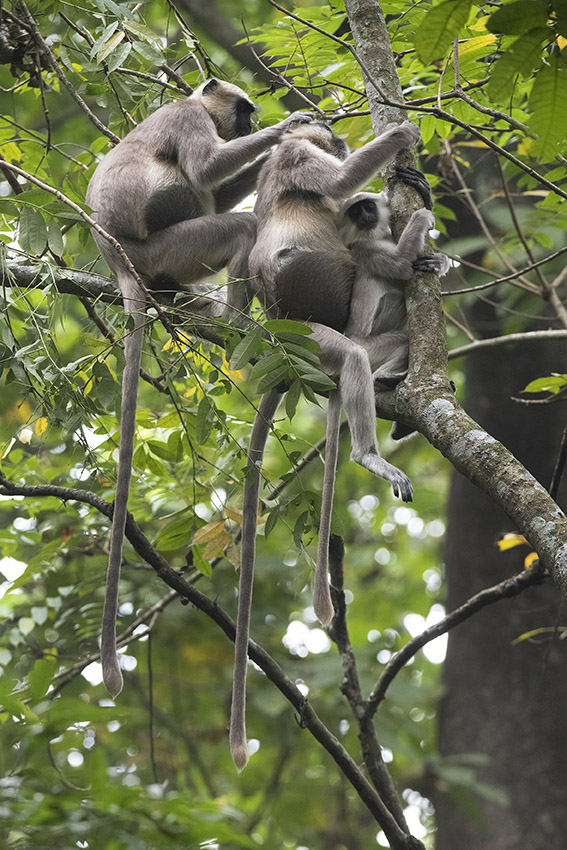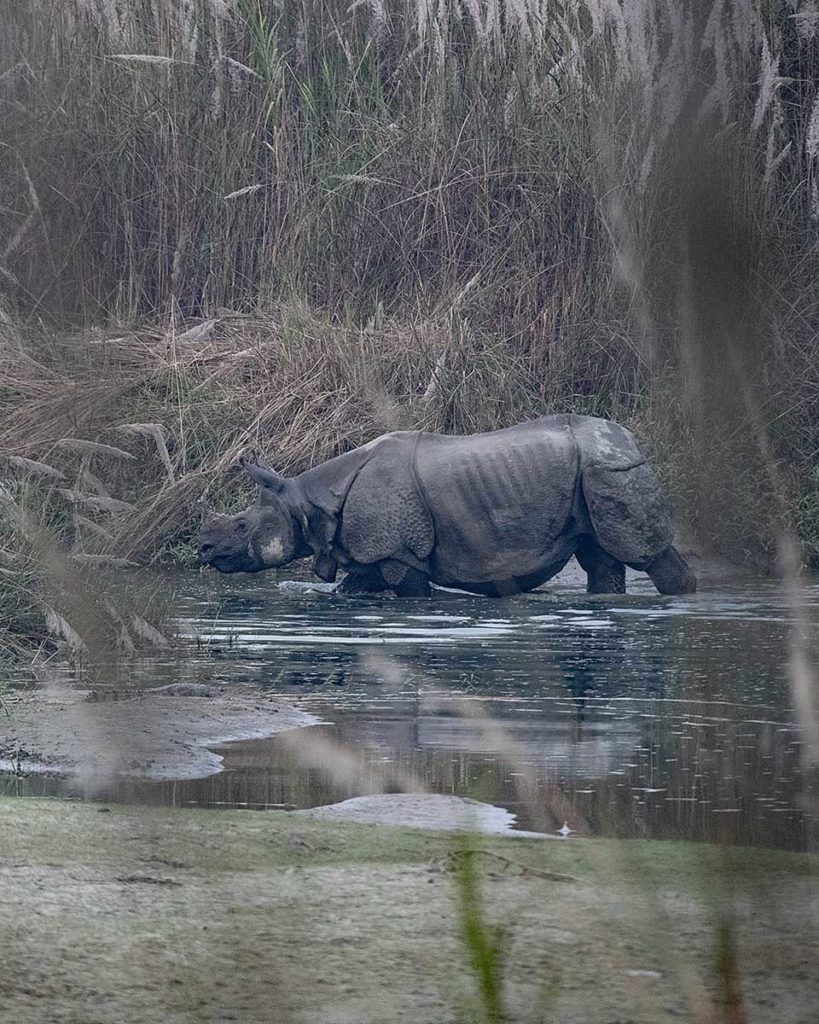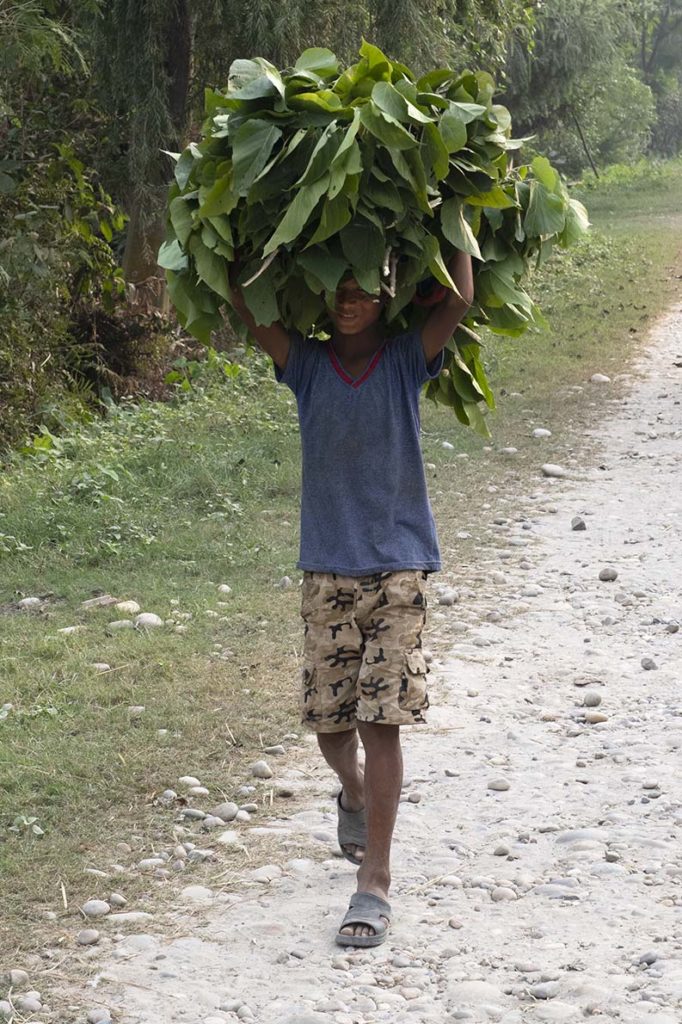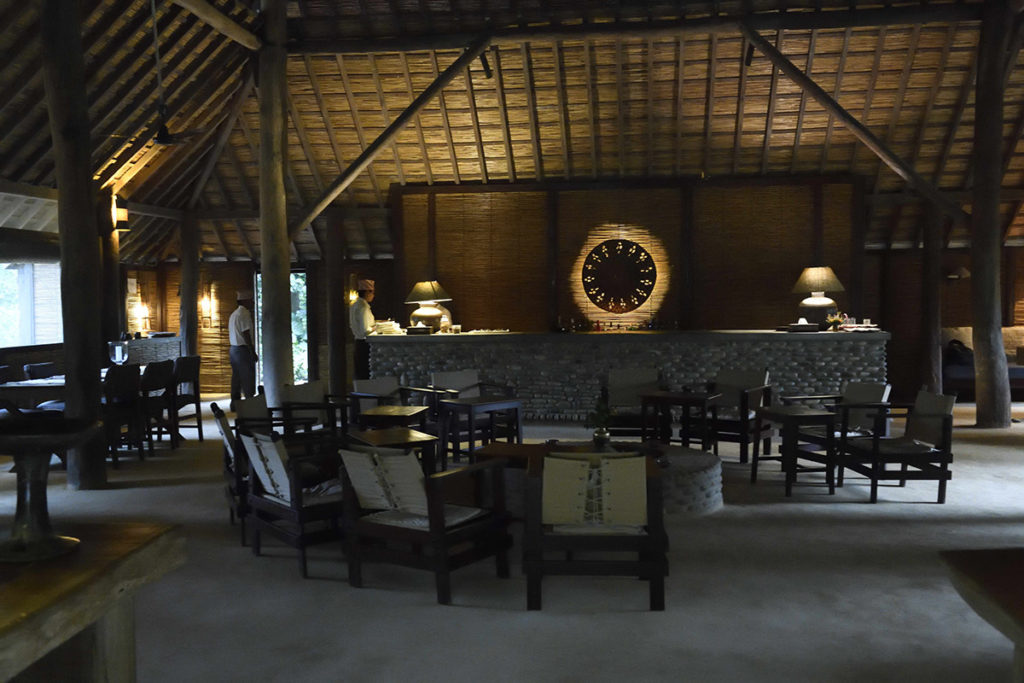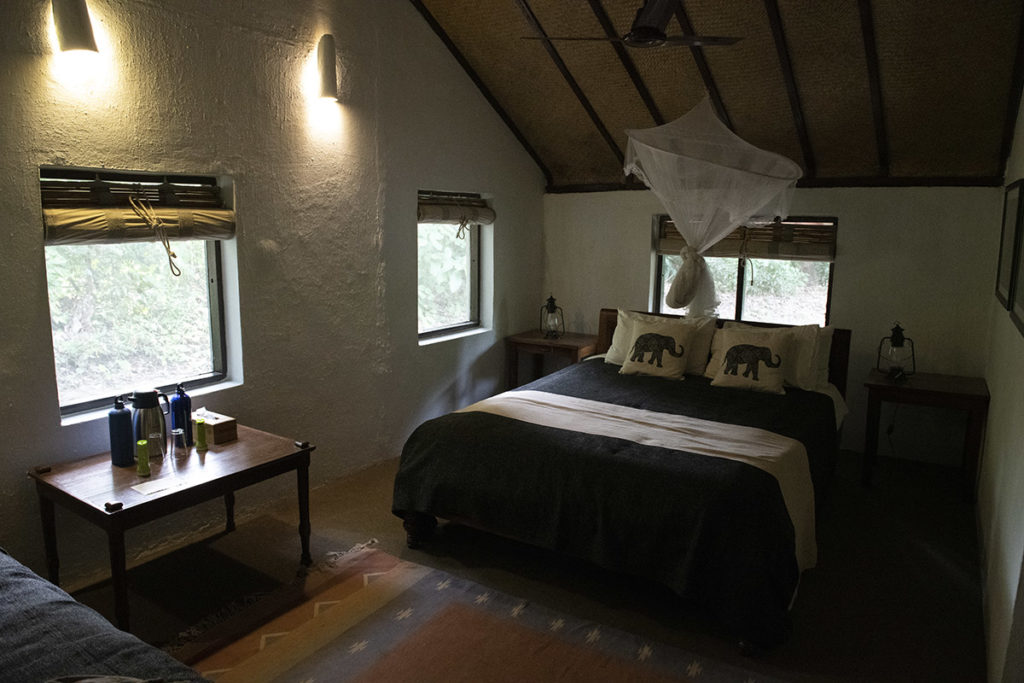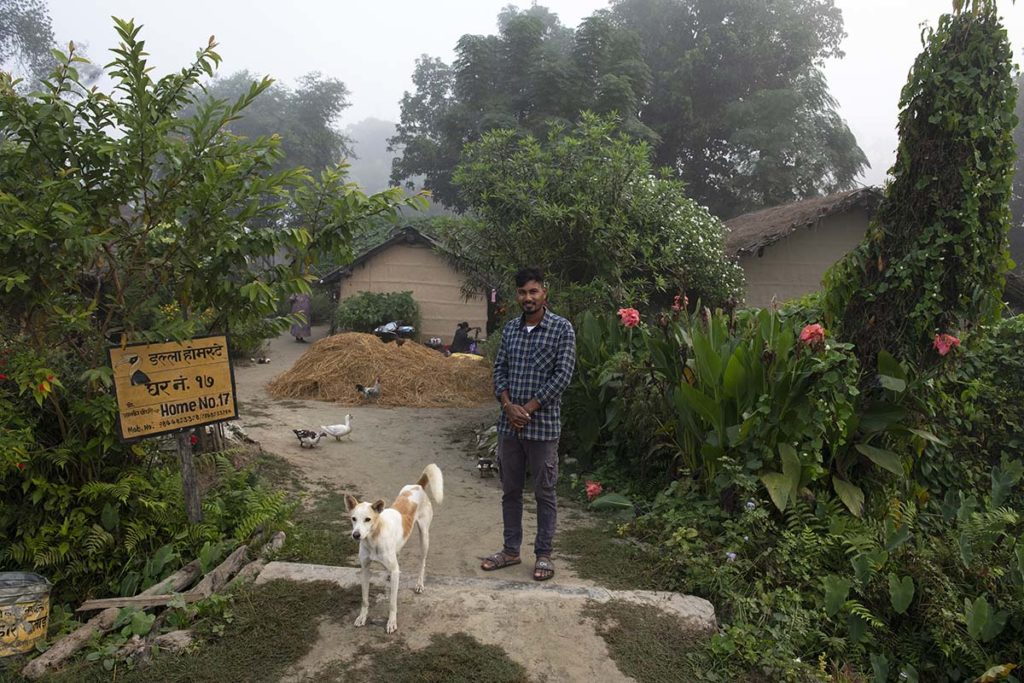Thousands of travelers visit the roof of the world in the Himalayas every year. But Nepal is a land of extremes with pristine rainforests as well. And in the dense forests of Chitwan and Bardia lives one of the most endangered animals in the world: the Bengal tiger.
Text: Angelique van Os | Photography: Henk Bothof
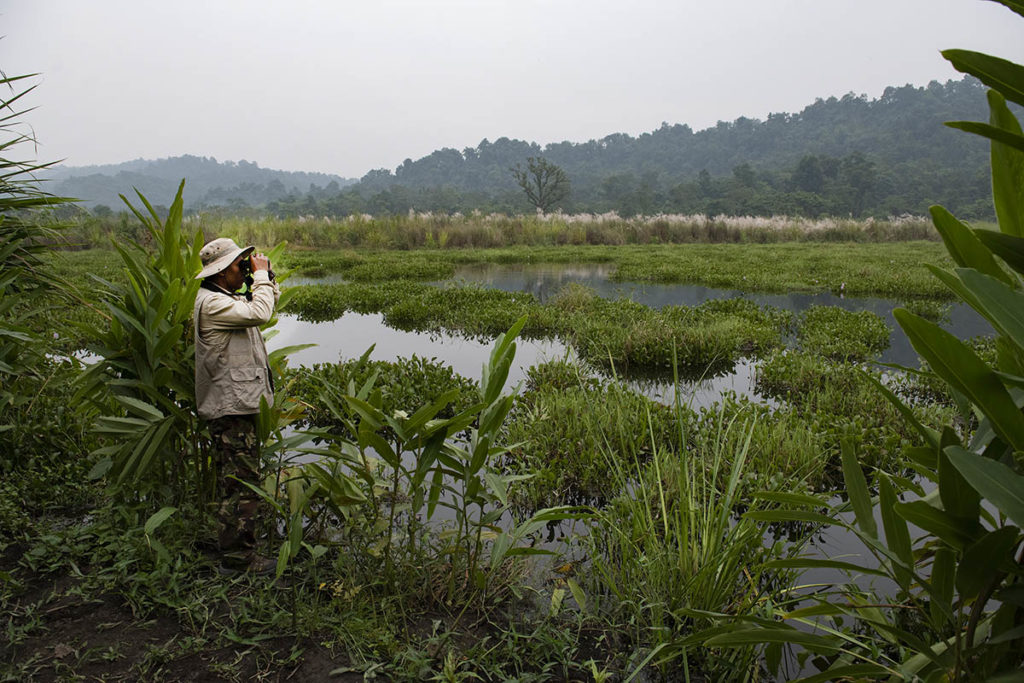
It can happen any time. Out of nowhere, a large, graceful figure can stroll along the sandy path with firm strides. Leaving his deep footprints in the earth. The black stripe pattern camouflages his orange fur that glistens in the early morning sun: the tiger. I am brutally shaken awake from my daydream when our guide Dhan Bahadur Chaudhary, DB for short, slams on the brakes. We’re less than five minutes away on a bumpy dirt track in Chitwan National Park (Nepal) before he has already found a fresh tiger track. Hanging over the car door, he looks at the ground. “This is from a male. You can tell by the size and the distance between the toes and nails. They are bigger than a female.”
He gets out and walks around the tracks. “Probably the Bengal tiger went for a drink at the river.” We quietly follow the guide, who only carries a stick for protection. DB follows the footprints like a sniffing hunting dog. The adrenaline rises. After about fifty meters there is no trace left.
Bengal tiger
Perhaps the Phantera tigris , the largest and strongest feline in the world, is hiding as much as five meters away. Disappointment sets in. And that is not the last time, because the Bengal tiger is not easy to see. Rightly so, because the number of wild tigers has decreased by 95 percent since the beginning of the last century (about 97,000!). According to the latest count of the World Wildlife Fund in 2019, there are only an estimated 3,900 wild tigers worldwide. Tigers are poisoned and poached for their fur, as a trophy and because tiger bones are an important ingredient in traditional Asian medicines. Furthermore, there are increasing human-animal conflicts and only seven percent of the original habitat has been preserved. (Bengal) tigers once migrated from Eastern Turkey and Russia to Asia.
Tiger countries India and Nepal
Although the tiger population is not yet doing well worldwide, the numbers are steadily increasing. Most tigers (about 2967) live in India. The chance of spotting them there is greatest, although tourism prevails there. The neighboring country Nepal follows with 235 tigers. It is the only tiger country that has doubled its population in nine years, although the numbers fluctuate. In Chitwan National Park we hear from DB that according to the latest count there are 93 tigers instead of the announced 120. That number has decreased due to heavy flooding and fights with rhinos in 2017.
Ideal hiding place
Driving through the fairytale rainforest of Chitwan, we understand all too well why tigers like to stay here. The other, green face of Nepal is the ideal hiding place. In the lowlands of the Terai region hundreds of square kilometers of pristine subtropical forests alternate with savannahs and river networks. They form corridors with India that are vital for the largest predator, as well as migrating elephants and rhinos. Chitwan is the most famous and oldest National Park in Nepal, which was declared a UNESCO World Heritage Site in 1973 because of its biodiversity.
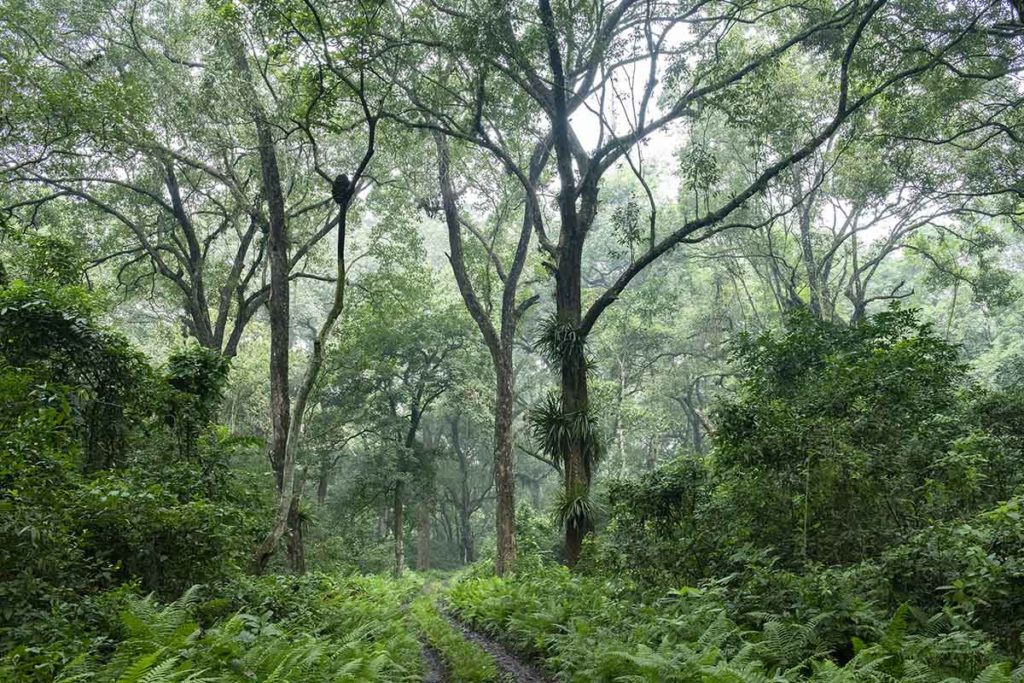
Old hunting lodge
As a wildlife manager, DB runs Tiger Tops Tharu Lodge , which has been in existence since 1964. Both here and in Bardia, Tiger Tops, in collaboration with wildlife organizations such as the Nepal Tiger Trust , uses camera traps to monitor the tiger population. They also cooperate with anti-poaching patrols, there are educational projects and scientific research. Arriving at Tharu’s old settlement, DB says that two Texans, Toddy Lee Wynne and Herb Klein, used the building as a hunting lodge. Conservationist Jim Edwards and sustainable tourism pioneer Chuck McDougl transformed the company in 1971 into a non-hunting wildlife organization. DB: “From 1982 we had to move the residence to its current location in order to provide more local employment. Hopefully we can restore the old state in the future.” That desire is understandable, because the location and the view over the river banks and grasslands are truly beautiful.
Armored rhinoceros
Suddenly DB puts his finger in front of his mouth. At less than twenty meters something rustles in the grass. The guide silently takes his stick and we sneak up behind him. Suddenly he makes a halt gesture. We go down on our haunches. Softly he whispers, “We have to be careful. There is a rhinoceros with a calf ten meters away. If she sees or smells us and feels threatened, she may attack us to protect her young. Let’s go back to the field and wait behind a tree.” With over twenty years of experience, DB knows exactly what he is doing. Patiently we wait for the armored one-horned rhinoceros.
This species lives only in the Terai region and in the north-eastern river banks of India. These animals are also almost extinct; there are approximately 1700 copies left. The female may have smelled us, because she circles the field. “Come on, she’s going to the river!” At an appropriate distance we run after the rhinoceros. Just in time we see the two slide into the water and cross the river.
Buffer zone
The next morning we drive to the other side of the park. The buffer zone between the inhabited world and the jungle consists only of a shallow river and a strip of grass. DB tells us that the people are well informed by and work together with patrolling army posts and nature conservationists. This monitoring is of vital importance for the tiger and the reason they flourish in Nepal. “For the past ten years, not a single tiger has poached in Chitwan. Unfortunately, poisoning still occurs when tigers eat cattle. Luckily locals keep their distance and know how to get themselves and their cattle to safety. They are quicker to raise the alarm at the army posts. The fact that we don’t have any more tigers is partly due to the dense population. This makes the cats fight for each other’s territories and food and limits the chances of survival of the young.”
Surprised
After an enchanting stretch of forest and a sea of ferns, we reach open grasslands. Through years of lobbying, DB, together with the villagers, has turned 200 hectares of forest landscape into a rich savannah. As a result, there are more deer and therefore tigers. We quietly sneak one more time behind DB through the tall grass. Unfortunately, the striped cats are nowhere to be seen. We continue our way by jeep. Again we are surprised by a rhino standing in the middle of the road. He disappears into the undergrowth and then dives into a ditch. DB drives the car a little further. A little later the rhinoceros appears curiously from the bushes and stares at us at less than five meters, only to disappear a little later in the dense greenery. ->>
TOFTigers
Sustainable tourism
TOFTigers has been focusing on sustainable tourism in India and its subcontinent since 2004, and advises governments on this. Involvement and commitment of locals play a key role in this. TOFTigers also focuses on raising awareness among travelers who visit wildlife parks. There are now 300 members from the travel industry connected to TOFT, from international tour operators to travel agents and accommodation. The Dutch travel organization All for Nature Travel works together with both organizations (see box). Julian Matthews, founder of TOFTigers: “Nepal’s success is due to the good work that organizations like Tiger Tops do. Locals feel involved because they play a role in the maintenance of the forest, which provides them with the basic necessities of life. It creates work and ensures better border regulation between wildlife and villages, which is a problem in any buffer zone. This system works well. We awarded Tiger Tops an Award for this in 2016,” says Matthews.
Tiger countries
In 2010, the cry for help with only 3200 tigers was so great that thirteen so-called tiger countries decided to take joint action (TX-2 Project). India and Nepal are the exceptions, but the goal of doubling the number of tigers by 2022 is, according to DB, Julian Matthews and the Himalayan Tiger Foundation not realistic. Matthews believes that there are too few habitats and many prey animals such as deer (chitals) and wild pigs are regularly poached for their meat, leaving too little for the Bengal tigers. In India, for example, this is a major problem. “If tigers are given enough space and food and have good water supplies, they can expand quickly,” he says.
Update tiger population 2020-2023
Between 2020-2023, the tiger population in Nepal doubled. We speak to DB about this and he reports that the peace in the parks during COVID-19 has benefited the tigers. In addition, more living space has been created in Chitwan and the habitat for the tigers has been adapted in such a way that they can find more food there. The downside during the pandemic is that in the case of Chitwan, the problems in the buffer zone have increased because fewer rangers were active and ready and subsidies for the local population were not forthcoming. The result: more human-wildlife conflicts, because tigers and rhinoceroses once again visited the cattle. Fortunately, there is increasing awareness among the local communities about how to act if tigers or rhinoceroses enter their villages. The lack of tourism during the pandemic – a 60% decrease – also made protecting people and wildlife more difficult to maintain. Tiger Tops tries to maintain the problems surrounding the buffer zone in collaboration with the National Park with their responsible tourism, which is now increasing again. The numbers now consist of:
| Park name | Numbers |
|---|---|
| Chitwan NP | 128 |
| Bardia NP | 125 |
| Parsa NP | 41 |
| Bank NP | 45 |
| Suklaphanta NP | 36 |
Tigernomics
Protection and habitats are too limited in countries such as China, Thailand, Myanmar and Indonesia. It is mostly a political, economic issue, Matthews believes. He continues his story: “I believe in ‘tigernomics’, because sustainable tourism can save the cat. Countries that claim that they cannot afford such protection have other interests. After several studies we can say that the positive effects and returns of good management and regulated tourism in certain parks in India and Nepal are many times higher than the investments. It is a mindset that must be changed to save the tiger.”
TIP: TOFTigers publishes almost every year a specialized guide full of the best tiger parks and sustainable lodges that are also committed to nature conservation.
Bardia
->>The Bengal tiger can also be found in the less crowded Bardia National Park . The habitat of the Bengal tiger has expanded due to the amalgamation of nearby Banke National Park . The parks have no less than 75 army posts that guard the entire area. They thus form a safe haven of 2,231 square kilometers. In 2019, between 93 and 97 tigers were spotted in Bardia. Due to strict supervision, poaching has not occurred for six years. Unfortunately, there are sometimes human-animal conflicts, largely caused by the limited buffer zone.
Bardia has been a National Park since 1988 and is very similar in vegetation to Chitwan, although the forest is less dense. Among other things, the rare Ganges dolphins, sloth bears, gharials (crocodiles with elongated mouth), some rhinoceroses, elephants and leopards live here. After a pleasant stay in a Homestay (see box) just outside the park, Bhim Bahadur Thanet picks us up early in the morning by jeep. He is our new guide and has been associated with Tiger Tops for over 33 years. He has an incredible amount of knowledge about tigers and life in the park and talks about it extensively.
Fresh tiger tracks
Along the way we find a lot of fresh tiger tracks and excrement. We wait fifteen minutes, sometimes half an hour at various viewpoints where animals regularly cross and drink water, but we are not lucky. Even if you are in the perfect spot, the animal should just pass by. A tiger sleeps five to twelve hours, in contrast to other cats that nap for eighteen hours. Due to the mobility and the dense vegetation, it is therefore more difficult to spot the animals. A tiger also marks its territory of about three kilometers in circles by spraying and leaving stripes. This makes it difficult even for trained trackers to trace the start or end point of a track and know which way the animal is going.
Confusing
However, Bhim does not give up, and in the early afternoon he discovers a fresh trail. “This is only an hour old, I guess. The paw print is completely clean, without smearing. Probably from a big male”, the guide whispers. Bhim explores the path. It is confusing, because the track goes in several directions. As if the tiger had changed his mind. We jump in the car and drive around the savannah and through the forest. Nothing. After a big round we return to the starting point of the trail.
Alarm call
A group of deer walks on the field. Suddenly they stop and stare alertly at the tall grass. A warning cry from a monkey follows. “Tiger!” says Bhim excitedly. “That is an alarm call. Look, the deer are running!” New, smaller tracks have been added. Bhim follows the monkey’s gaze. “Come with me!” He grabs his bamboo stick and we run after him. And then, about 100 meters away, the outline of a Bengal tiger appears. Everything goes very fast. The meeting lasts only 1 minute, because the female has heard us. She glances over her shoulder and stares at us for a few seconds. My breath catches. Then she quickly disappears into the grass. What an intense experience! “Tigresses are very shy and quickly run away. The males can walk proudly on the sand path,” whispers Bhim, panting from the sprint.
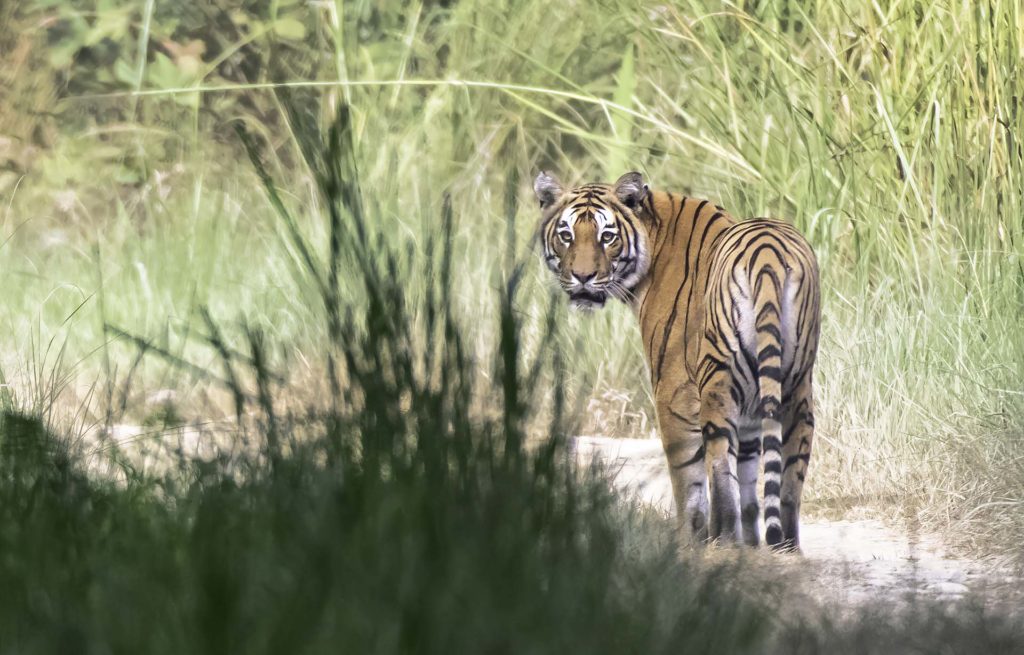
Dense green
Bhim wants to make another attempt to find the tiger. We hurry back to the car. Unfortunately that doesn’t work. But after a while, a high-pitched desperate bark is heard: a Muntjak, a ‘barking’ deer, is being killed. We continue on foot again. That is a risk in the meter-high grass, but we trust the guide. “If we hit a tiger, stay in line behind me. Whatever happens, don’t run away and don’t panic, because he will come after you.”
We make our way through the dense greenery. My gaze darts in all directions and my heart beats in my throat. More cries follow; we’re getting closer. The tension ebbs away when we see a group of deer disappear towards the river. Their alertness diminishes, the danger has passed. Walking along the bank, Bhim recognizes marking tracks. “This is a different man than this morning. We are in a borderland of two tigers with several tigresses,” he whispers. We hide in the bushes and wait. On the other side we suddenly hear a kind of soft smacking and creaking bones, but unfortunately the tiger does not appear. We’re going back.
blood smell
Suddenly a very strong smell of blood comes towards us. Bhim: “Look at the flat grass, a tiger has been lying there. I suspect the cat has dragged his prey a bit further. We’re not going to look there, it’s too dangerous.” In a few hours, almost three different tigers have seen and the tension was cut.
Own plan
The next two days we are less lucky: it is busy in the park. According to Bhim, the increasing number of cars disturbs the peace of the Bengal tigers. They hide more and it creates stress.
During our last game drive we wait almost three hours at a beautiful viewpoint and only see some deer and monkeys. At another, higher point on the water, our waiting is rewarded. A large athletic body moves with stately strides through the low water. Through the binoculars I see his beautiful coat glistening even more beautifully than in my daydream.
Unfortunately, the tiger does not walk along the river bed. He crosses over and as unexpectedly as he came, he has disappeared again. We try to wait for him in the jeep in another place, but the tiger again has its own plan. In the distance only the alarm of the barking deer sounds. After that it remains silent. And we no longer hear any trace of the almost invisible Bengal tiger. ![]()
Nepal practical
How to get there
There are no direct flights from the Netherlands to the capital Kathmandu; there are several providers (flight tickets €650-€1100). Fly to Bharatpur: 50 minutes, followed by a one-hour drive to Chitwan. By car: six hours, over bad, winding mountain roads. Chitwan-Bardia: more than a day’s drive. Flying: from Nepalgunj airport. Yeti Airlines compensates its CO2 emissions with sustainable projects.
Best travel time Bengal tiger
Bardia and Chitwan: open mid-October-May. Best time for the tiger: February-April, because the grass is lower and it is not so hot yet.
Travel organization
Do you also want to go on safari in Nepal? All for Nature Travel made this trip (including the accommodations mentioned) possible and specializes in the most beautiful wildlife trips around the world. One of the ways in which you can contribute to nature conservation is sustainable tourism. All for Nature Travel donates at least five percent of the travel sum to the protection of the Bengal tiger and its habitat. In addition, €25 per booking goes to TOFTigers, to be spent on local projects that promote nature conservation. The combination of Bardia and Chitwan with a stay in the Tiger Top Lodges can be booked from EUR 2795.00 pp. For a combination with the Himalayas, All for Nature recommends the Royal Nature & Wildlife tour.
More info
A valid visa is required in Nepal. This is best arranged in advance via the Consulate General of Nepal in Amsterdam or Brussels. Costs: €50. The necessary vaccinations and malaria pills are also required.
Stay tips
Tiger Tops Karnali Logde
Like big brother Tharu in Chitwan, Karnali breathes serenity. In the total of 21 rooms, the minimalistic local interior of mud houses has been applied everywhere and earthy tones, reed and bamboo serve as the basis. The same goes for the restaurant annex lounge room, where good organic food is served. Both Karnali and Tharu work exclusively with Nepalese people, draw energy from solar panels and received several awards from TOFTigers.
community homestay
If you want to stay close to the locals, sleep at their house! Ten years ago, WWF initiated a partnership with the community outside Bardia to host guests. There are approximately 22 households participating. The rooms are simple, but equipped with electricity and running water. Only the beds are very hard. The people are very cordial and it is a nice experience to cook together and make contact. The concept also offers hostesses their own source of income. A great initiative that you can book for one night via All for Nature Travel.
Barber Mahal Vilas
Before or after your adventures in the wilderness, you can relax in Barber Mahal Vilas. In this chic boutique hotel with courtyard garden and swimming pool and sauna on the roof, you forget the hectic pace of Kathmandu. The villa is part of a larger palace complex, which was built in 1913 by order of the then Prime Minister, Maharaja Chandra Shumsher for his son Baber. The property is quite unique due to four architectural styles: neoclassical Rana Durbar, Newari, Mustang and Terai design. The spacious rooms are classically furnished and have a regal feel.
This trip was made possible by All for Nature Travel, Tiger Tops and supported by the Dutch Consulate General of Nepal. Thanks also to Nikon Netherlands for making an AF-S 200-400 mm lens available.


